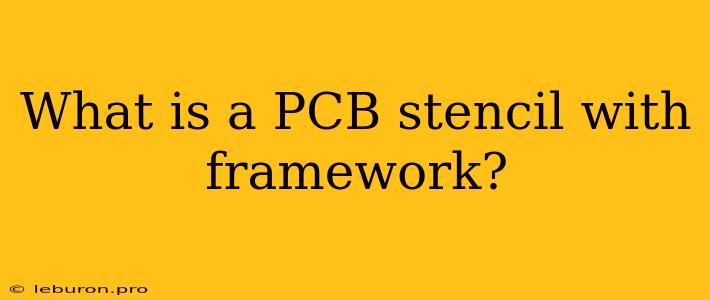What is a PCB Stencil with Framework?
A PCB stencil is a crucial component in the surface mount technology (SMT) assembly process. It acts as a template for precisely depositing solder paste onto the pads of a printed circuit board (PCB). But what is a PCB stencil with a framework, and how does it differ from a standard stencil? This article will delve into the intricacies of PCB stencils with frameworks, exploring their advantages, disadvantages, and various applications.
Understanding the Basics of PCB Stencils
Before diving into the specifics of frameworks, let's understand the fundamentals of PCB stencils. These are thin, usually stainless steel, sheets with precisely cut openings that align with the solder paste pads on a PCB. When solder paste is applied to the stencil, it passes through these openings, forming a precise deposit onto the pads. This ensures a consistent and accurate amount of solder paste is dispensed onto the PCB, crucial for the proper soldering of surface mount components.
Introducing the Framework: What is it and Why Use it?
A PCB stencil with a framework is essentially a stencil with an additional structural element that enhances its durability and stability. This framework is typically made of a robust material like steel or aluminum and is directly attached to the stencil. It provides support to the stencil's frame, ensuring its rigidity and minimizing any potential warping or bending during the SMT process.
Here's why frameworks are beneficial:
- Increased Durability: Frameworks enhance the overall structural integrity of the stencil, making it more resistant to deformation and wear and tear. This translates to a longer lifespan and reduced maintenance needs.
- Improved Alignment and Accuracy: The framework provides additional stability, ensuring precise alignment of the stencil with the PCB during the solder paste dispensing process. This leads to increased accuracy in solder paste deposition and ultimately, a more reliable and consistent SMT assembly.
- Reduced Vibrations and Movement: The framework significantly minimizes vibrations and movements during the SMT process. These vibrations can lead to inconsistencies in solder paste deposition and compromise the overall quality of the assembly.
Understanding the Types of Frameworks
There are two main types of frameworks used in PCB stencils:
1. Frameless Stencils:
These are the most basic type of stencil and lack any additional framework structure. They are often used for small and simple PCBs with fewer components. Frameless stencils are typically less expensive than their counterparts with frameworks.
2. Framed Stencils:
These stencils have a robust framework added to the stencil body, providing increased stability and durability. Framed stencils are often preferred for larger and more complex PCBs with a high component density.
Applications of PCB Stencils with Frameworks
PCB stencils with frameworks find extensive use in various industries and applications, including:
- Electronics Manufacturing: Frameworks are widely used in the manufacturing of consumer electronics, medical devices, automotive components, and other electronic devices.
- High-Volume Production: They are particularly suitable for high-volume production lines where maintaining consistency and accuracy is crucial.
- Large and Complex PCBs: Framed stencils excel in handling large and complex PCBs with numerous components and intricate designs.
- Precision Applications: The increased accuracy and stability provided by frameworks make them ideal for applications demanding high precision and consistency.
Advantages and Disadvantages of PCB Stencils with Frameworks
Advantages:
- Increased Stencil Durability: Frameworks enhance the lifespan of the stencil, reducing the need for frequent replacements.
- Improved Alignment and Accuracy: The added support leads to more accurate solder paste deposition, contributing to better soldering quality.
- Reduced Vibrations and Movement: The framework provides stability and reduces vibrations, minimizing errors in the SMT process.
- Enhanced Flexibility: Frameworks can be customized to accommodate specific PCB designs and component configurations.
Disadvantages:
- Higher Cost: Framed stencils are generally more expensive than frameless stencils due to the additional materials and manufacturing processes.
- Increased Complexity: The presence of a framework can make cleaning and maintenance slightly more complex.
- Limited Accessibility: In some cases, the framework may limit access to certain areas of the stencil, potentially hindering cleaning and maintenance.
Factors to Consider When Choosing a PCB Stencil with a Framework
- PCB Size and Complexity: Consider the size and complexity of the PCB, as larger and more complex designs may require the added support of a framework.
- Production Volume: High-volume production lines benefit from the increased durability and reliability offered by framed stencils.
- Component Density: PCBs with high component density necessitate precise solder paste deposition, which can be achieved through the stability provided by frameworks.
- Budget: Evaluate the cost of framed stencils and compare it to the benefits they provide.
Conclusion
PCB stencils with frameworks represent a crucial advancement in SMT assembly technology. The added support they provide enhances accuracy, stability, and durability, leading to better overall assembly quality. While the initial cost may be higher, the long-term benefits in terms of production efficiency, reduced errors, and improved component longevity make them a compelling investment for manufacturers seeking to optimize their SMT processes. By understanding the features, applications, and considerations surrounding PCB stencils with frameworks, engineers and manufacturers can make informed decisions to achieve optimal performance and efficiency in their SMT operations.
